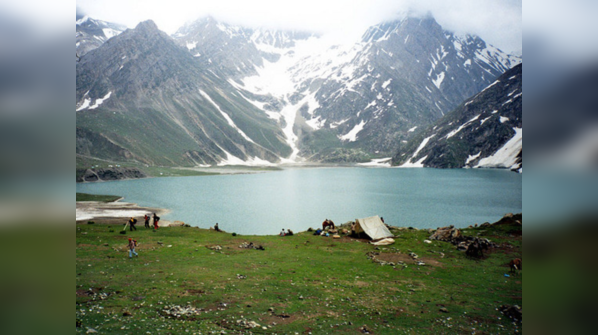Top 7 Indian destinations that look nothing like India and are a must-visit

Top 7 Indian destinations that look nothing like India and are a must-visit
India’s full of surprises, and some of its destinations look like they've wandered out of a postcard. From French boulevards in Puducherry to Switzerland vibes in Himachal, these spots will have you second-guessing the map. Ready to tour the world without leaving the country? Get ready to explore the country’s most surreal wonders.

Gucchu Pani/Robbers Cave, Uttarakhand
Robbers Cave is an iconic picnic spot located in Dehradun, Uttarakhand, that attracts young couples, students, and fun-loving enthusiasts alike. Located just 8 km away from Dehradun city center, this unique tourist attraction offers its visitors a unique chance to explore its captivating cave, which is accented by a cool and revitalizing stream of water. This is a natural river cave formation, which is about 600 m long and is divided into two main sections. Local legend says that robbers used to hide here during the British colonial era, hence the name. The best time to visit this cave is from March to June and from September to November.

Sheshnag Lake, Jammu and Kashmir
Nestled in the Anantnag district of Jammu and Kashmir, Sheshnag Lake is one of India’s most stunning high-altitude lakes. Steeped in mythology, the lake holds both spiritual significance and breathtaking natural beauty. Situated at an altitude of 3,590 meters (11,780 feet), it is encircled by snow-capped mountains and lush green meadows. According to Hindu mythology, the lake is named after Sheshnag, the king of serpents and a companion of Lord Shiva. It is believed that Sheshnag himself created the lake and now resides in its waters, making it a sacred site for pilgrims, particularly those on the Amarnath Yatra. While the lake remains frozen for most of the year, the best time to visit is between June and August, when the snow melts, and the lake becomes accessible.

Lahaul Valley, Himachal Pradesh
Known for its raw natural beauty, rich Buddhist culture, and dramatic landscapes, Lahaul Valley is a paradise for trekkers, bikers, and peace seekers. This valley lies north of the Rohtang Pass, along with the Chandra and Bhaga rivers, which merge to form the Chenab River. It rests at an altitude of 3,000 to 4,500 meters above sea level and is surrounded by glacial rivers and barren mountains. Apart from its scenic beauty, this valley is home to beautiful and culturally rich monasteries like Keylong, Kardang, and Gondhla, reflecting strong Tibetan influence.

Dhanushkodi, Tamil Nadu
Dhanushkodi, meaning “end of the bow,” is also known as “ghost town”. Dhanushkodi lies on the Rameshwaram island, at a point where the Bay of Bengal meets the Indian Ocean. It's India's easternmost extremity that one can reach by road and the last land point from Sri Lanka, which is merely around 30 km away via the sea. Dhanushkodi is believed to be the place where Lord Rama and his army built the Ram Setu with floating stones to cross over to Lanka and rescue Sita Mata. If you are planning to visit this place, remember that no overnight stays are allowed here. You can travel by road from Rameswaram; there is a scenic stretch called the Dhanushkodi road, which takes you right to the tip. Dhanushkodi offers scenic ruins, Arichal Munai, confluence of seas, serene beaches, turquoise waters, and distant views of Sri Lanka.

Nubra Valley, Ladakh
Hidden away past the imposing Khardung La Pass, Nubra Valley is a landscape of breathtaking contrasts, where sandy dunes are desolate alongside icy rivers and great mountains. Famous for its endemic double-humped Bactrian camels, the valley is a mixture of alpine and desert loveliness. Monasteries such as Diskit impart a spiritual beauty to their unrefined landscape. The Shyok and Nubra rivers cut through the valley, forming fertile spots in the middle of the cold desert. Visiting here is like entering another world—unspoiled, dreamlike, and unforgettable.
June to September is the best time to visit Nubra Valley when the weather is pleasant, and roads are accessible.

Amkhoi forest, West Bengal
Situated around Bolpur in West Bengal, the Amkhoi Forest is a secluded treasure famous for its fossil park and serene environment. The forest was brought into the limelight after the local people found the fossils of plants dated millions of years ago, which are now preserved and set up in the park. The tall sal trees, red soil tracks, and off-and-on bird calls make it a serene sojourn into nature. Unlike other tourist areas that are commercialized, Amkhoi gives an unspoiled and hands-on forest adventure. It's the ideal sanctuary for nature buffs, history fans, and quiet adventurers in search of a stroll through time and timber.

Puga valley, Ladakh
Located deep within Ladakh's remoteness, Puga Valley is a geothermal wonderland where the raw power of the earth is fully unleashed. The valley is studded with hissing hot springs and geysers, expelling sulfur steam into the cool mountain air. The colorful, mineral-drenched soil is a jarring contrast to the bleak, arid terrain that surrounds it. Famous for its sulfur deposits, Puga is a geothermal hotspot, and its surreal beauty draws scientists and adventurers to its shores. Traveling to the valley is like entering a natural laboratory where the power of the Earth and nature meet in a grand dance.








